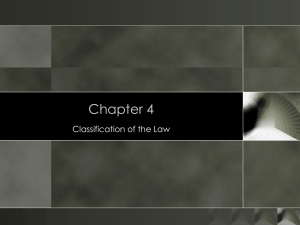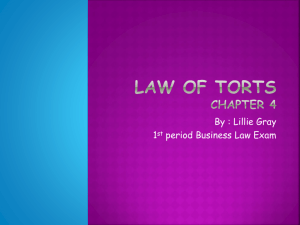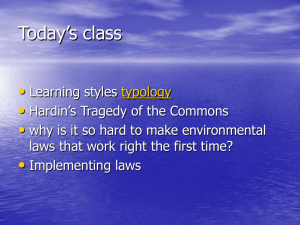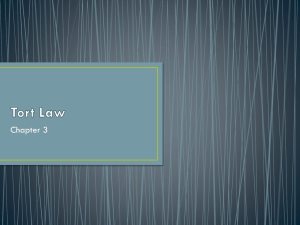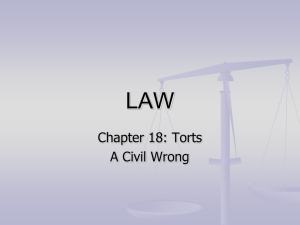Civil Law
advertisement
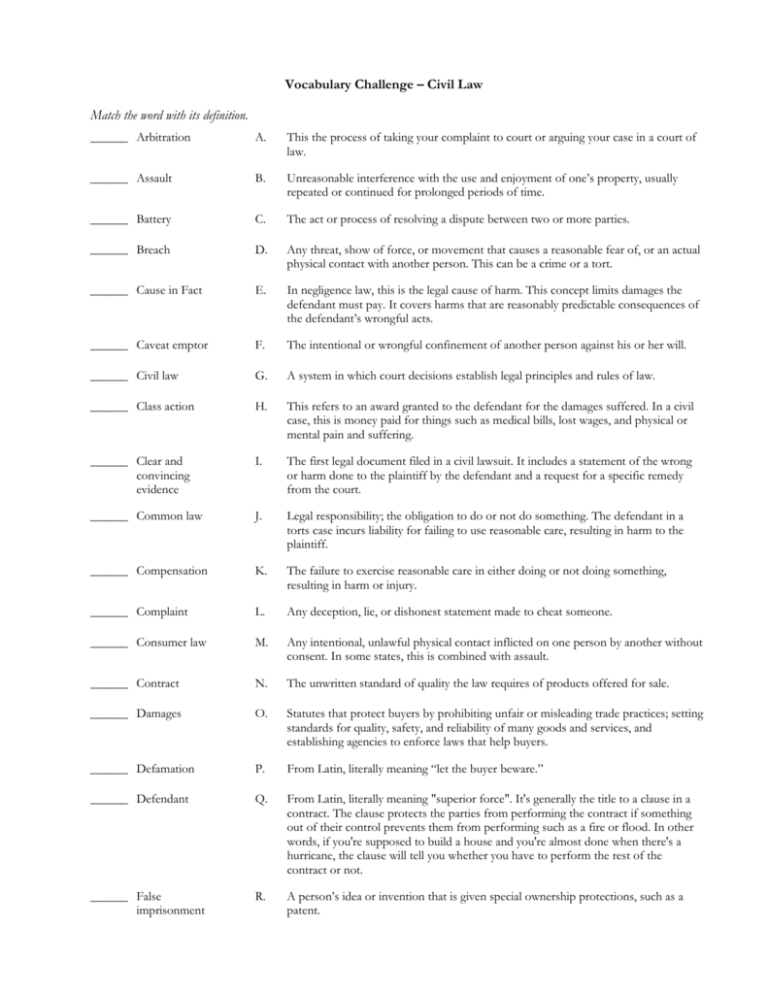
Vocabulary Challenge – Civil Law Match the word with its definition. ______ Arbitration A. This the process of taking your complaint to court or arguing your case in a court of law. ______ Assault B. Unreasonable interference with the use and enjoyment of one’s property, usually repeated or continued for prolonged periods of time. ______ Battery C. The act or process of resolving a dispute between two or more parties. ______ Breach D. Any threat, show of force, or movement that causes a reasonable fear of, or an actual physical contact with another person. This can be a crime or a tort. ______ Cause in Fact E. In negligence law, this is the legal cause of harm. This concept limits damages the defendant must pay. It covers harms that are reasonably predictable consequences of the defendant’s wrongful acts. ______ Caveat emptor F. The intentional or wrongful confinement of another person against his or her will. ______ Civil law G. A system in which court decisions establish legal principles and rules of law. ______ Class action H. This refers to an award granted to the defendant for the damages suffered. In a civil case, this is money paid for things such as medical bills, lost wages, and physical or mental pain and suffering. ______ Clear and convincing evidence I. The first legal document filed in a civil lawsuit. It includes a statement of the wrong or harm done to the plaintiff by the defendant and a request for a specific remedy from the court. ______ Common law J. Legal responsibility; the obligation to do or not do something. The defendant in a torts case incurs liability for failing to use reasonable care, resulting in harm to the plaintiff. ______ Compensation K. The failure to exercise reasonable care in either doing or not doing something, resulting in harm or injury. ______ Complaint L. Any deception, lie, or dishonest statement made to cheat someone. ______ Consumer law M. Any intentional, unlawful physical contact inflicted on one person by another without consent. In some states, this is combined with assault. ______ Contract N. The unwritten standard of quality the law requires of products offered for sale. ______ Damages O. Statutes that protect buyers by prohibiting unfair or misleading trade practices; setting standards for quality, safety, and reliability of many goods and services, and establishing agencies to enforce laws that help buyers. ______ Defamation P. From Latin, literally meaning “let the buyer beware.” ______ Defendant Q. From Latin, literally meaning "superior force". It's generally the title to a clause in a contract. The clause protects the parties from performing the contract if something out of their control prevents them from performing such as a fire or flood. In other words, if you're supposed to build a house and you're almost done when there's a hurricane, the clause will tell you whether you have to perform the rest of the contract or not. ______ False imprisonment R. A person’s idea or invention that is given special ownership protections, such as a patent. ______ Force majeure S. Written or spoken expression about a person that is false and damages that person’s reputation. ______ Fraud T. This is the standard of proof used in certain lawsuits and in regulatory agency cases. It governs the amount of proof that must be offered in order for the plaintiff to win the case. ______ Implied warranty U. A breach of some obligation causing harm or injury to someone. A civil wrong, such as negligence or libel. ______ Injunction V. These courts are especially designed to handle disputes between individuals, or an individual making a claim against a business, where the amount of money involved is relatively "small" – at least in terms of the cases courts usually decide. They typically can hear disputes that involve amounts that range from $1,000 to $5,000. The precise limit depends on the local laws in each jurisdiction. In some states, these courts can also handle minor disputes between individuals and a government agency. ______ Intellectual property W. A written expression about a person that is false and damages that person’ reputation. ______ Liability X. Spoken expression about a person that is false and damages that person’s reputation. ______ Libel Y. In a civil case, the injured party who brings an action against the alleged wrongdoer. ______ Litigation Z. A lawsuit brought by one or more persons on behalf of a larger group. ______ Malpractice AA. A court order requiring a person to do or refrain from doing a particular act. ______ Mediation BB. The violation of a law, duty, or other form of obligation, either by engaging in an action or failing to act. ______ Negligence CC. The person against whom a claim is made. In a civil suit, the defendant is the person being sued. ______ Nuisance DD. One of the elements the plaintiff must prove to win a negligence suit. To do this, the plaintiff must prove he or she would not have been harmed if the defendant had not acted wrongfully. ______ Plaintiff EE. A way of settling a dispute without going to trial. The people who disagree select an impartial person to settle the argument. If the process is binding, the decision must be followed by all parties. ______ Preponderance of evidence FF. All law that does not involve criminal matters. This usually deals with private rights of individuals, groups or business. ______ Proximate cause GG. This is usually the standard of proof in a civil case. In order to win the suit, the plaintiff must provide evidence that is more convincing than the other’s side. ______ Slander HH. Failure to meet acceptable standards of practice in any professional or official position; often the basis for lawsuits by clients or patients against their attorney or doctor. ______ Small claims court II. The unexcused intrusion on, or improper use of, property belonging to another person. This can be the basis of an intentional tort. ______ Tort JJ. This refers to compensation - such as a money judgment - provided to a person who has suffers a loss or harm due to the unlawful act or omission of another. The person at fault - the one who is the proximate cause of the loss or harm - must compensate the injured party. ______ Trespass KK. A legally enforceable agreement between two or more people. Answer Sheet Arbitration B Nuisance D Assault Y Plaintiff M Battery GG BB Breach E Proximate cause DD Cause in Fact X Slander Caveat emptor V Small claims court Civil law U Tort Z Class action II Trespass T Clear and convincing evidence G Common law H Compensation I Complaint O Consumer law EE P FF KK Contract JJ Damages S Defamation CC Defendant F False imprisonment Q Force majeure L Fraud N Implied warranty AA Injunction R Intellectual property J Liability W Libel A Litigation HH Malpractice C Mediation K Negligence Preponderance of evidence

